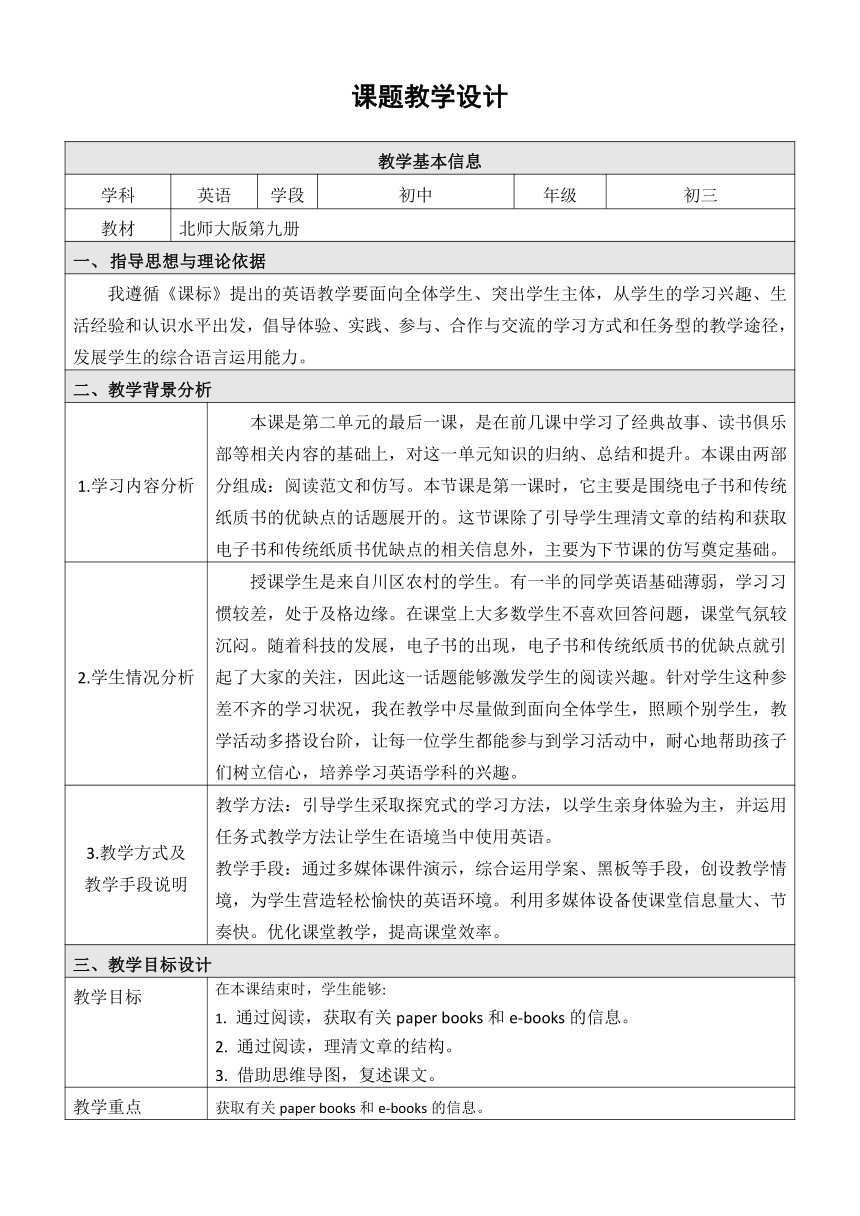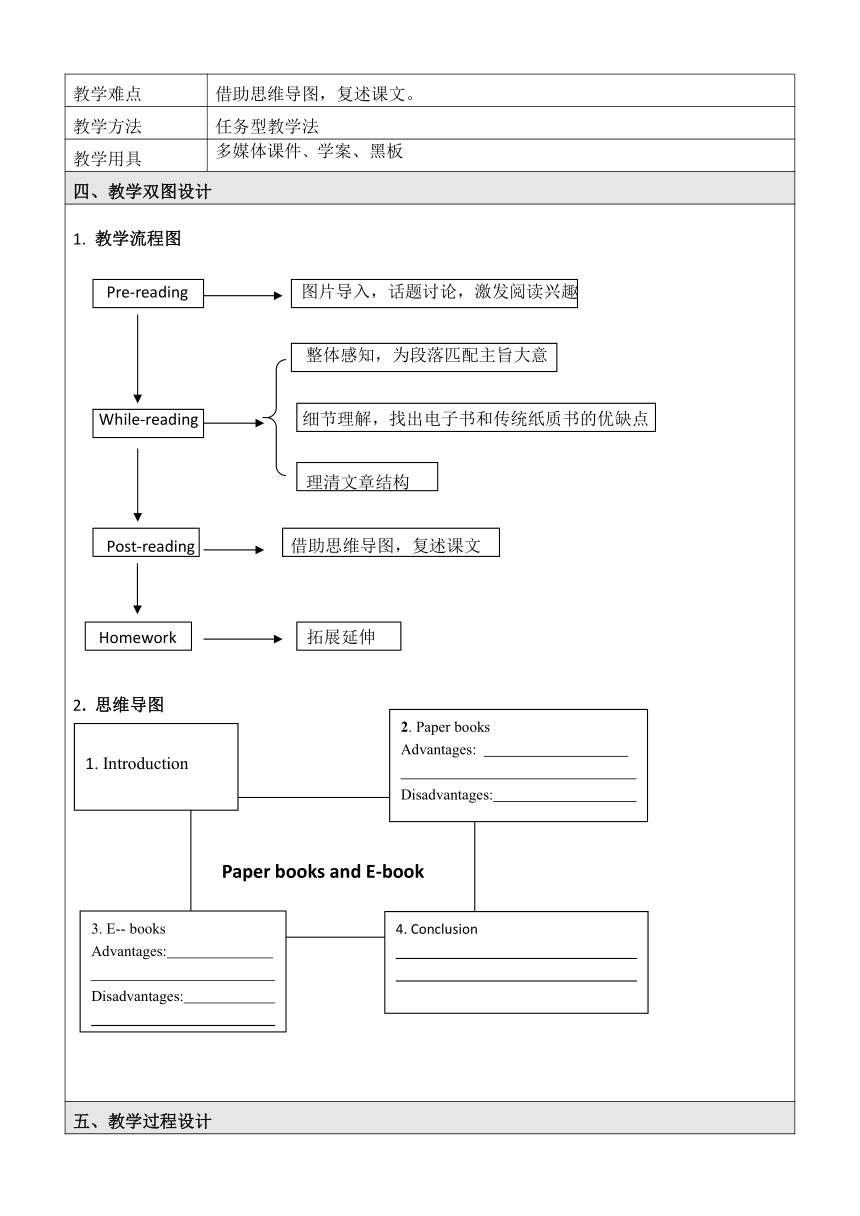Unit 2 Books Communication Workshop 教案(表格式)
文档属性
| 名称 | Unit 2 Books Communication Workshop 教案(表格式) |  | |
| 格式 | docx | ||
| 文件大小 | 44.3KB | ||
| 资源类型 | 教案 | ||
| 版本资源 | 北师大版 | ||
| 科目 | 英语 | ||
| 更新时间 | 2021-09-29 17:14:48 | ||
图片预览


文档简介
课题教学设计
教学基本信息
学科
英语
学段
初中
年级
初三
教材
北师大版第九册
指导思想与理论依据
我遵循《课标》提出的英语教学要面向全体学生、突出学生主体,从学生的学习兴趣、生活经验和认识水平出发,倡导体验、实践、参与、合作与交流的学习方式和任务型的教学途径,发展学生的综合语言运用能力。
二、教学背景分析
1.学习内容分析
本课是第二单元的最后一课,是在前几课中学习了经典故事、读书俱乐部等相关内容的基础上,对这一单元知识的归纳、总结和提升。本课由两部分组成:阅读范文和仿写。本节课是第一课时,它主要是围绕电子书和传统纸质书的优缺点的话题展开的。这节课除了引导学生理清文章的结构和获取电子书和传统纸质书优缺点的相关信息外,主要为下节课的仿写奠定基础。
2.学生情况分析
授课学生是来自川区农村的学生。有一半的同学英语基础薄弱,学习习惯较差,处于及格边缘。在课堂上大多数学生不喜欢回答问题,课堂气氛较沉闷。随着科技的发展,电子书的出现,电子书和传统纸质书的优缺点就引起了大家的关注,因此这一话题能够激发学生的阅读兴趣。针对学生这种参差不齐的学习状况,我在教学中尽量做到面向全体学生,照顾个别学生,教学活动多搭设台阶,让每一位学生都能参与到学习活动中,耐心地帮助孩子们树立信心,培养学习英语学科的兴趣。
3.教学方式及
教学手段说明
教学方法:引导学生采取探究式的学习方法,以学生亲身体验为主,并运用任务式教学方法让学生在语境当中使用英语。
教学手段:通过多媒体课件演示,综合运用学案、黑板等手段,创设教学情境,为学生营造轻松愉快的英语环境。利用多媒体设备使课堂信息量大、节奏快。优化课堂教学,提高课堂效率。
三、教学目标设计
教学目标
在本课结束时,学生能够:
1.
通过阅读,获取有关paper
books和e-books的信息。
2.
通过阅读,理清文章的结构。
3.
借助思维导图,复述课文。
教学重点
获取有关paper
books和e-books的信息。
教学难点
借助思维导图,复述课文。
教学方法
任务型教学法
教学用具
多媒体课件、学案、黑板
四、教学双图设计
1.
教学流程图
Pre-reading
图片导入,话题讨论,激发阅读兴趣
整体感知,为段落匹配主旨大意
While-reading
细节理解,找出电子书和传统纸质书的优缺点
理清文章结构
Post-reading
借助思维导图,复述课文
Homework
拓展延伸
(
1
.
Introduction
)
(
2
.
Paper
books
Advantages:
Disadvantages:
)
(
Paper
books
and
E-book
)2.
思维导图
(
3.
E--
books
Advantages:
Disadvantages:
)
(
4.
Conclusion
)
五、教学过程设计
教学环节
教师活动
学生活动
设计意图
Step
1:
Pre-reading
Show
Ss
a
picture,
and
ask
them
to
answer
the
questions:
Which
is
better
for
you
to
read,
paper
books
or
e-books
And
Why
Look
at
the
picture
and
have
a
discussion
图片导入以及相关问题讨论,激发学生的阅读兴趣,引出本课话题。
Step
2:
While-reading
1.Ask
Ss
to
look
at
the
text
and
answer
the
questions:
Q1:
What
kind
of
text
is
this
Q2:
How
many
paragraphs
are
there
in
the
text
Q3:What
can
we
learn
from
the
title
“Books
and
E-books”
2.Have
Ss
read
Jenny’s
blog
and
match
the
function
of
each
paragraph
with
the
paragraphs.
3.
Check
the
answers
1.
Look
at
the
text
and
number
the
paragraphs.
2.
Read
Jenny’s
blog
and
match
3.
Give
the
reasons.
整体感知,初步理解课文主旨大意,并体会从标题快速入手获取信息的阅读策略。
1.Ask
Ss
to
read
Jenny’s
blog
again
and
complete
the
sentences
with
e-books
or
paper
books.
2.
Check
the
answers.
3.
Direct
Ss
to
read
Para.
2
and
Para.3
and
underline
the
advantages
and
disadvantages
of
paper
books
and
e-books.
4.
Read
Para.
4
and
answer
the
question:
What
does
the
writer
think
of
these
two
kinds
of
books
1.Read
Jenny’s
blog
again
and
complete
the
sentences
2.
Give
the
reasons.
3.
Read
Para.
2
and
Para.3
and
underline
4.
Read
Para.4
and
answer
the
question
培养学生获取细节信息的能力。
获取较难一些的表层信息
Step
3:
Post-reading
1.
Ask
Ss
to
Listen
and
read
the
passages
after
the
speaker.
Underline
the
words
or
phrases
that
you
couldn’t
understand
clearly
with
pencils.
2.
Direct
Ss
to
try
to
retell
the
passage
according
to
the
mind
map
on
the
blackboard.
1.
Listen
and
read
the
passage
after
the
speaker.
Underline
some
difficult
words
or
phrases.
2.
Try
to
retell
the
passage
朗读课文,纠正语音;发现生词或短语,进一步理解课文。内化课文。
复述课文,进一步内化信息,为下节课的写作打好基础
作业布置
Write
a
paragraph
using
“I
prefer
…to…for
several
reasons…….”
六、板书设计
Unit
2
Communication
Workshop
(
2
.
Paper
books
Advantages
:
easy
to
buy,
comfortable
to
read,
make
notes
easily,
Disadvantages:
can
be
heavy
and
are
not
easy
to
carry
around
)
(
1
.
Introduction
)
(
Paper
books
and
E-book
)
(
3.
E--
books
Advantages
:
can
be
stored
in
a
reader
(lighter),
have
a
dictionary
to
check
new
words
quickly,
Disadvantages
:
only
get
on
line,
must
read
on
an
e-book
reader,
a
computer,
or
a
smart
phone
(extra
cost),
eyes
can
get
tired
easily
)
(
4.
Conclusion
It
doesn’t
matter
which
you
use
as
long
as
it
allows
you
to
enjoy
reading.
)
七、学习效果评价设计
学习效果评价设计:
自评
1.I
can
understand
the
text.
2.I
can
read
the
text
frequently.3.I
can
retell
the
text
according
to
the
mind
map
八、教学设计特色说明与教学反思
1.本课的教学设计以学生为主体,遵循学生的特点和语言学习规律,有层次、有梯度的开展语言学习,最终实现从学生思维训练到阅读能力的提高。
2.
学生利用老师给的思维导图,明确了文章结构。
3.在读中的活动中,精读给学生的时间有点不够,感觉有点仓促。在今后的阅读教学中,阅读任务的布置,一定要给学生充分的时间去读,让学生更好的完成阅读任务。
教学基本信息
学科
英语
学段
初中
年级
初三
教材
北师大版第九册
指导思想与理论依据
我遵循《课标》提出的英语教学要面向全体学生、突出学生主体,从学生的学习兴趣、生活经验和认识水平出发,倡导体验、实践、参与、合作与交流的学习方式和任务型的教学途径,发展学生的综合语言运用能力。
二、教学背景分析
1.学习内容分析
本课是第二单元的最后一课,是在前几课中学习了经典故事、读书俱乐部等相关内容的基础上,对这一单元知识的归纳、总结和提升。本课由两部分组成:阅读范文和仿写。本节课是第一课时,它主要是围绕电子书和传统纸质书的优缺点的话题展开的。这节课除了引导学生理清文章的结构和获取电子书和传统纸质书优缺点的相关信息外,主要为下节课的仿写奠定基础。
2.学生情况分析
授课学生是来自川区农村的学生。有一半的同学英语基础薄弱,学习习惯较差,处于及格边缘。在课堂上大多数学生不喜欢回答问题,课堂气氛较沉闷。随着科技的发展,电子书的出现,电子书和传统纸质书的优缺点就引起了大家的关注,因此这一话题能够激发学生的阅读兴趣。针对学生这种参差不齐的学习状况,我在教学中尽量做到面向全体学生,照顾个别学生,教学活动多搭设台阶,让每一位学生都能参与到学习活动中,耐心地帮助孩子们树立信心,培养学习英语学科的兴趣。
3.教学方式及
教学手段说明
教学方法:引导学生采取探究式的学习方法,以学生亲身体验为主,并运用任务式教学方法让学生在语境当中使用英语。
教学手段:通过多媒体课件演示,综合运用学案、黑板等手段,创设教学情境,为学生营造轻松愉快的英语环境。利用多媒体设备使课堂信息量大、节奏快。优化课堂教学,提高课堂效率。
三、教学目标设计
教学目标
在本课结束时,学生能够:
1.
通过阅读,获取有关paper
books和e-books的信息。
2.
通过阅读,理清文章的结构。
3.
借助思维导图,复述课文。
教学重点
获取有关paper
books和e-books的信息。
教学难点
借助思维导图,复述课文。
教学方法
任务型教学法
教学用具
多媒体课件、学案、黑板
四、教学双图设计
1.
教学流程图
Pre-reading
图片导入,话题讨论,激发阅读兴趣
整体感知,为段落匹配主旨大意
While-reading
细节理解,找出电子书和传统纸质书的优缺点
理清文章结构
Post-reading
借助思维导图,复述课文
Homework
拓展延伸
(
1
.
Introduction
)
(
2
.
Paper
books
Advantages:
Disadvantages:
)
(
Paper
books
and
E-book
)2.
思维导图
(
3.
E--
books
Advantages:
Disadvantages:
)
(
4.
Conclusion
)
五、教学过程设计
教学环节
教师活动
学生活动
设计意图
Step
1:
Pre-reading
Show
Ss
a
picture,
and
ask
them
to
answer
the
questions:
Which
is
better
for
you
to
read,
paper
books
or
e-books
And
Why
Look
at
the
picture
and
have
a
discussion
图片导入以及相关问题讨论,激发学生的阅读兴趣,引出本课话题。
Step
2:
While-reading
1.Ask
Ss
to
look
at
the
text
and
answer
the
questions:
Q1:
What
kind
of
text
is
this
Q2:
How
many
paragraphs
are
there
in
the
text
Q3:What
can
we
learn
from
the
title
“Books
and
E-books”
2.Have
Ss
read
Jenny’s
blog
and
match
the
function
of
each
paragraph
with
the
paragraphs.
3.
Check
the
answers
1.
Look
at
the
text
and
number
the
paragraphs.
2.
Read
Jenny’s
blog
and
match
3.
Give
the
reasons.
整体感知,初步理解课文主旨大意,并体会从标题快速入手获取信息的阅读策略。
1.Ask
Ss
to
read
Jenny’s
blog
again
and
complete
the
sentences
with
e-books
or
paper
books.
2.
Check
the
answers.
3.
Direct
Ss
to
read
Para.
2
and
Para.3
and
underline
the
advantages
and
disadvantages
of
paper
books
and
e-books.
4.
Read
Para.
4
and
answer
the
question:
What
does
the
writer
think
of
these
two
kinds
of
books
1.Read
Jenny’s
blog
again
and
complete
the
sentences
2.
Give
the
reasons.
3.
Read
Para.
2
and
Para.3
and
underline
4.
Read
Para.4
and
answer
the
question
培养学生获取细节信息的能力。
获取较难一些的表层信息
Step
3:
Post-reading
1.
Ask
Ss
to
Listen
and
read
the
passages
after
the
speaker.
Underline
the
words
or
phrases
that
you
couldn’t
understand
clearly
with
pencils.
2.
Direct
Ss
to
try
to
retell
the
passage
according
to
the
mind
map
on
the
blackboard.
1.
Listen
and
read
the
passage
after
the
speaker.
Underline
some
difficult
words
or
phrases.
2.
Try
to
retell
the
passage
朗读课文,纠正语音;发现生词或短语,进一步理解课文。内化课文。
复述课文,进一步内化信息,为下节课的写作打好基础
作业布置
Write
a
paragraph
using
“I
prefer
…to…for
several
reasons…….”
六、板书设计
Unit
2
Communication
Workshop
(
2
.
Paper
books
Advantages
:
easy
to
buy,
comfortable
to
read,
make
notes
easily,
Disadvantages:
can
be
heavy
and
are
not
easy
to
carry
around
)
(
1
.
Introduction
)
(
Paper
books
and
E-book
)
(
3.
E--
books
Advantages
:
can
be
stored
in
a
reader
(lighter),
have
a
dictionary
to
check
new
words
quickly,
Disadvantages
:
only
get
on
line,
must
read
on
an
e-book
reader,
a
computer,
or
a
smart
phone
(extra
cost),
eyes
can
get
tired
easily
)
(
4.
Conclusion
It
doesn’t
matter
which
you
use
as
long
as
it
allows
you
to
enjoy
reading.
)
七、学习效果评价设计
学习效果评价设计:
自评
1.I
can
understand
the
text.
2.I
can
read
the
text
frequently.3.I
can
retell
the
text
according
to
the
mind
map
八、教学设计特色说明与教学反思
1.本课的教学设计以学生为主体,遵循学生的特点和语言学习规律,有层次、有梯度的开展语言学习,最终实现从学生思维训练到阅读能力的提高。
2.
学生利用老师给的思维导图,明确了文章结构。
3.在读中的活动中,精读给学生的时间有点不够,感觉有点仓促。在今后的阅读教学中,阅读任务的布置,一定要给学生充分的时间去读,让学生更好的完成阅读任务。
同课章节目录
- Unit 1 Language
- Lesson 1 Body Language
- Lesson 2 Different Kinds of Language
- Lesson 3 Language Learning Tips
- Communication Workshop
- Unit 2 Books
- Lesson 4 Classics
- Lesson 5 The Book Club
- Lesson 6 Tom Sawye
- Communication Workshop
- Unit 3 Creativity
- Lesson 7 A Famous Invento
- Lesson 8 Good or Bad?
- Lesson 9 Creative Minds
- Communication Workshop
- Unit 4 Space
- Lesson 10 Life in Space
- Lesson 11 The Amazing Shenzhou
- Lesson 12 The Spaceship
- Communication Workshop
- Unit 5 Literature
- Lesson 13 Anne of Green Gables
- Lesson 14 The Dark Room
- Lesson 15 A Famous Write
- Communication Workshop
- Unit 6 Role Models
- Lesson 16 Yao Ming
- Lesson 17 People in Our Lives
- Lesson 18 Steve Jobs
- Communication Workshop
- Unit 7 Journeys
- Lesson 19 The Silk Road
- Lesson 20 Life in a Journey
- Lesson 21 To the South Pole
- Communication Workshop
- Unit 8 Discoveries
- Lesson 22 Famous Discoveries
- Lesson 23 Discovery of the Yea
- Lesson 24 An Experiment Report
- Communication Workshop
- Unit 9 Save the Planet
- Lesson 25 Going Green
- Lesson 26 Our Rive
- Lesson 27 Tree Heroes
- Communication Workshop
